-
Who We Are
WHO WE AREThe Environmental Migration Portal is a one-stop service website to promote new research, information exchange and dialogue, intended to fill the existing data, research and knowledge gaps on the migration, environment and climate change (MECC) nexus.
IOM Global
IOM Global
-
Our Work
Our WorkThe Environmental Portal aims to centralize relevant and up-to-date research, data, and information on migration, environment and climate change and
provide information on recent activities of IOM, including with its partners, in addressing the migration, environment and climate change (MECC) nexus.What we do
What we do
- Where We Work
- Data and Resources
- 2030 Agenda
Now is a historical opportunity, and I take this occasion to urge States and all other relevant actors [...] to include human mobility in the Climate Agreement to be negotiated in Paris. There is still time to do so. Migration was anchored in the Climate Adaptation Framework in Cancun in 2010 -- after 10 long years of climate negotiations -- opening a whole new scope for action on climate and human mobility. Let’s not reverse the process and ignore human mobility - a defining feature of our time, a mega-trend of this century.
Keynote Address by William Lacy Swing, Director General of IOM at the Nansen Initiative Global Consultation
The International Organization for Migration (IOM), as the leading intergovernmental migration agency, has been at the forefront of operational, research, policy and advocacy efforts, seeking to bring environmental migration to the heart of international, regional and national concerns, in collaboration with its Member States, observers and partners. IOM’s work on Migration, Environment and Climate Change (MECC) has greatly expanded in the past five years, both in terms of the number of activities and as regards IOM’s engagement in external policy processes. In order to continue stepping up IOM’s engagement in this thematic area, a dedicated institutional structure, the “Migration, Environment and Climate Change Division” (MECC), was created within the organization, tasked with leading IOM’s work on migration, environment and climate change. For more information, please see IOM and Migration, Environment and Climate Change and Relevant Publications.
|
Climate change is a cause of human mobility |
Human mobility is an adaptation strategy to climate change |
Climate change policy should consider human mobility |
|---|---|---|
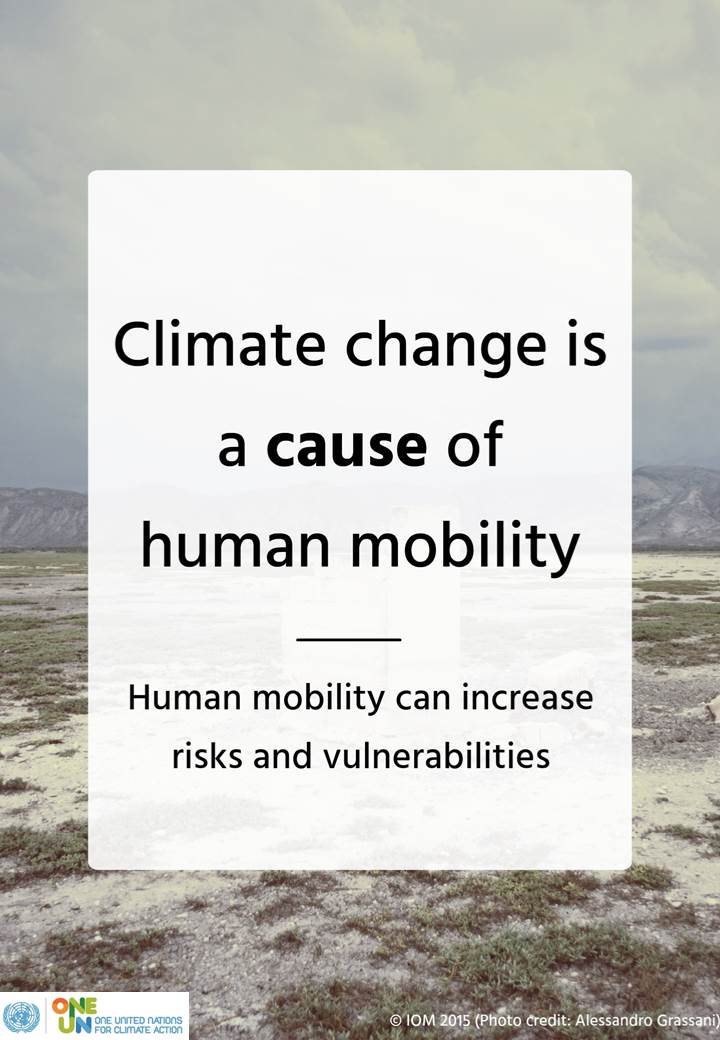
Environmental and climatic factors are both drivers and pull factors of migration, and are influenced by economic, social, political and demographic aspects. All these different dimensions together define a community and an individual’s resilience and vulnerability.
Mobility strategies of migrants are not inherently “positive” or “negative”. Mobility can save lives, enhance resilience and reduce risk – and it can also make people vulnerable and expose them to new risks.
Talking of migration in the context of climate change means giving a human face to the climate change debate. More emphasis needs to be placed on the migrants themselves, their families and the communities, on understanding their strategies, the challenges they face, and mobility options that are available to them. |
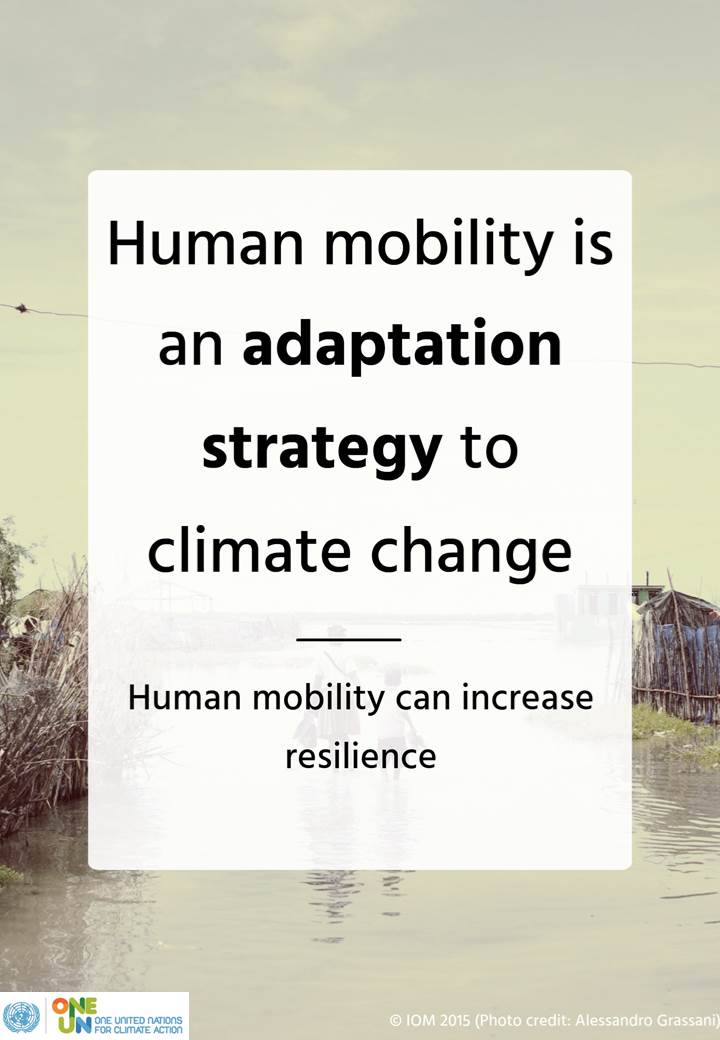
Individuals and communities use migration to adapt to changing environmental conditions. In some contexts, migration can constitute an important and positive adaptation strategy that can be supported by policy action. Human mobility matters should be factored in the National Adaptation Plans and in adaptation strategies.
The contributions of migrants and diasporas for instance through remittances, knowledge transfers and investments can serve adaptation purposes. The role of migration as an adaptation strategy to climate change can be facilitated. |
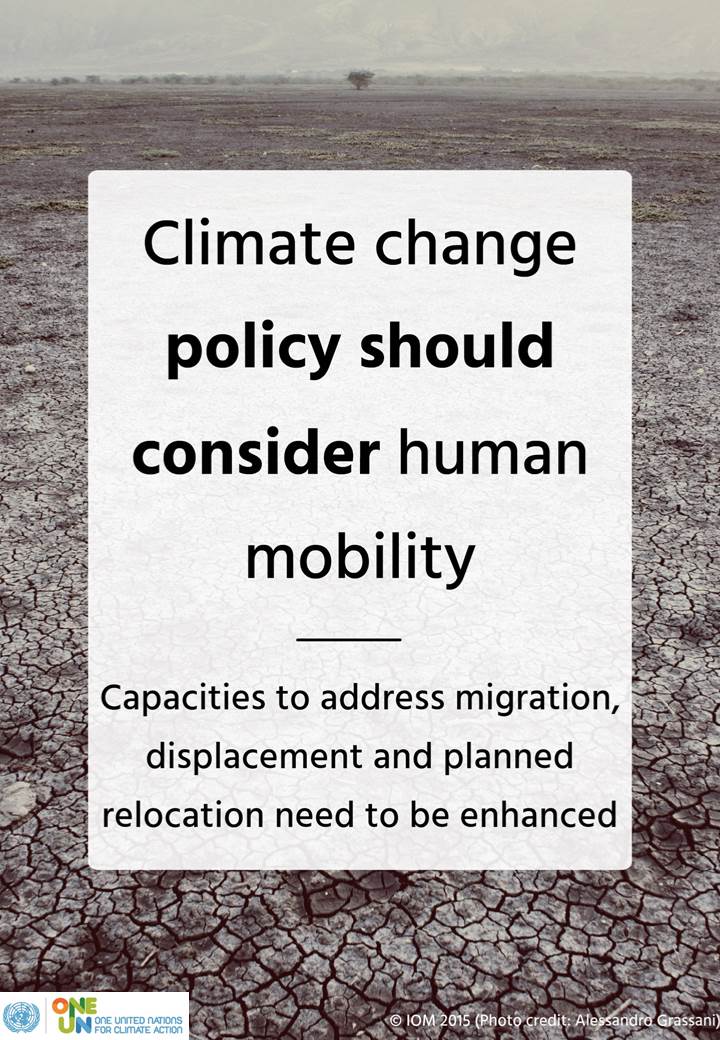
UNFCCC process should continue to include human mobility questions in its negotiations. Following major advances in Cancun in 2010 (decision 1.CP/16 paragraph 14 (f)) and in Doha in 2012 (decision on loss and damage 3.CP/18 paragraph 7 (a) (vi)), negotiations under the UNFCCC should continue to factor in and progress on the question of human mobility in relation to climate change.
Policymakers need to be empowered at the national, local, or regional and international levels to be able to address the complex nexus of migration, environment and climate. Climate and migration require common policy responses. |
IOM Migration, Environment and Climate Change Division at COP21
One UN High-level Side Event on Human mobility and Climate Change was held on the 10th of December 2015 13:15—14:45 (Observer Room 1, Hall 4, Blue Zone, Le Bourget, Paris), led by IOM in partnership with UNHCR, UNU, ILO and other organizations. Flyer

(Left) Panel speakers of the ONE UN High-Level Roundtable on Human Mobility and Climate Change (from left to right): Michelle Leighton (ILO Chief, Labour Migration Branch), chairing the Panel, Late Ambassador William Lacy Swing (Director General, International Organization for Migration), Nicolas Hulot (Special Envoy of the French President for the Protection of the Planet and President of the Nicolas Hulot Foundation), Alfredo Zamudio (Director General, The Internal Displacement Monitoring Centre), Monique Barbut (Executive Secretary, United Nations Convention to Combat Desertification), Volker Turk (Assistant High Commissioner, United Nations High Commissioner for Refugees), Seb Dance (Member of the European Parliament), Kyung-wha Kang (Assistant Secretary General, UN Office for the Coordination of Humanitarian Affairs), Philippe Lévêque (Executive Director, CARE France), Jan Egeland (Secretary General, Norwegian Refugee Council), Dr. Youba Sokona (Vice Chair, Intergovernmental Panel on Climate Change) and Dr. Kamal Uddin Ahmed (Secretary, Ministry of Environment and Forests - not in the picture).
(Right) Observer Room 1 during ONE UN High-Level Roundtable on Human Mobility and Climate Change.
Videos filmed after the ONE UN High-Level Roundtable on Human Mobility and Climate Change consist of interviews with Itinterunga Rae Bainteiti (One Young World delegate from Kiribati), Seb Dance (European Parliament), Marine Franck (UNHCR) and Alfredo Zamudio (IDMC).
One UN Exhibition on Human Mobility in a Changing Climate, could be visited throughout the two weeks of the UNFCCC negotiations in Paris, led by IOM in partnership with UNHCR and other organizations. For more information, please visit the UNSCEB website here, or the webpage dedicated to the UN system's joint engagement in COP21, developed by the CEB Secretariat here.

(Left) The International Organization for Migration at the One UN exhibition booth 'Human Mobility in a Changing Climate' (from left to right): Mariam Traore Chazalnoel (Associate Expert, Migration, Environment and Climate Change Division, IOM Geneva), Emma Proust (Project Assistant, IOM France), Daria Mokhnacheva (Project Officer, Migration, Environment and Climate Change Division, IOM France), Late Ambassador William Lacy Swing (Director General, International Organization for Migration), Dina Ionesco (Head of Migration, Environment and Climate Change Division, IOM Geneva) and Sara Abbas (Head of IOM France).
(Center) One UN exhibition booth (from left to right) with Mariam Traore Chazalnoel (Associate Expert, Migration, Environment and Climate Change Division, IOM Geneva), Marine Franck (Climate Change Officer, UNHCR) and Sieun Lee (Research Officer Migration, Environment and Climate Change: Evidence for Policy, IOM Geneva).
(Right) One UN exhibition booth on Human Mobility in a Changing Climate.
Photo exhibition | Entwined Destinies: Migration, Environment and Climate Change, displaying Alessandro Grassani's work, could be visited between 24 November and 17 January in the National Museum of the History of Immigration in Paris. In addition, the Exhibit presented to the public for the first time the maps from the Atlas of Environmental Migration (Editions Presses de Sciences Po and Routledge). Flyer Dépliant

(Left) Monique Barbut (Executive Secretary, United Nations Convention to Combat Desertification) at the launch of the Atlas of Environmental Migration
(Center) Official launch of the exhibition Entwined Destinies: Migration, Environment and Climate Change in the presence of photographer Alessandro Grassani, Head of Migration, Environment and Climate Change Division Dina Ionesco, Curator and IOM France Project Officer Daria Mokhnacheva.
(Right) Viewing of the exhibition.
Atlas of Environmental Migration is an innovative tool providing a visual overview of the trends of human migration in the context of environmental and climatic changes, through maps, illustrations and explanatory texts prepared under the supervision of world experts in this field. For the preview of the French booklet, please visit here.
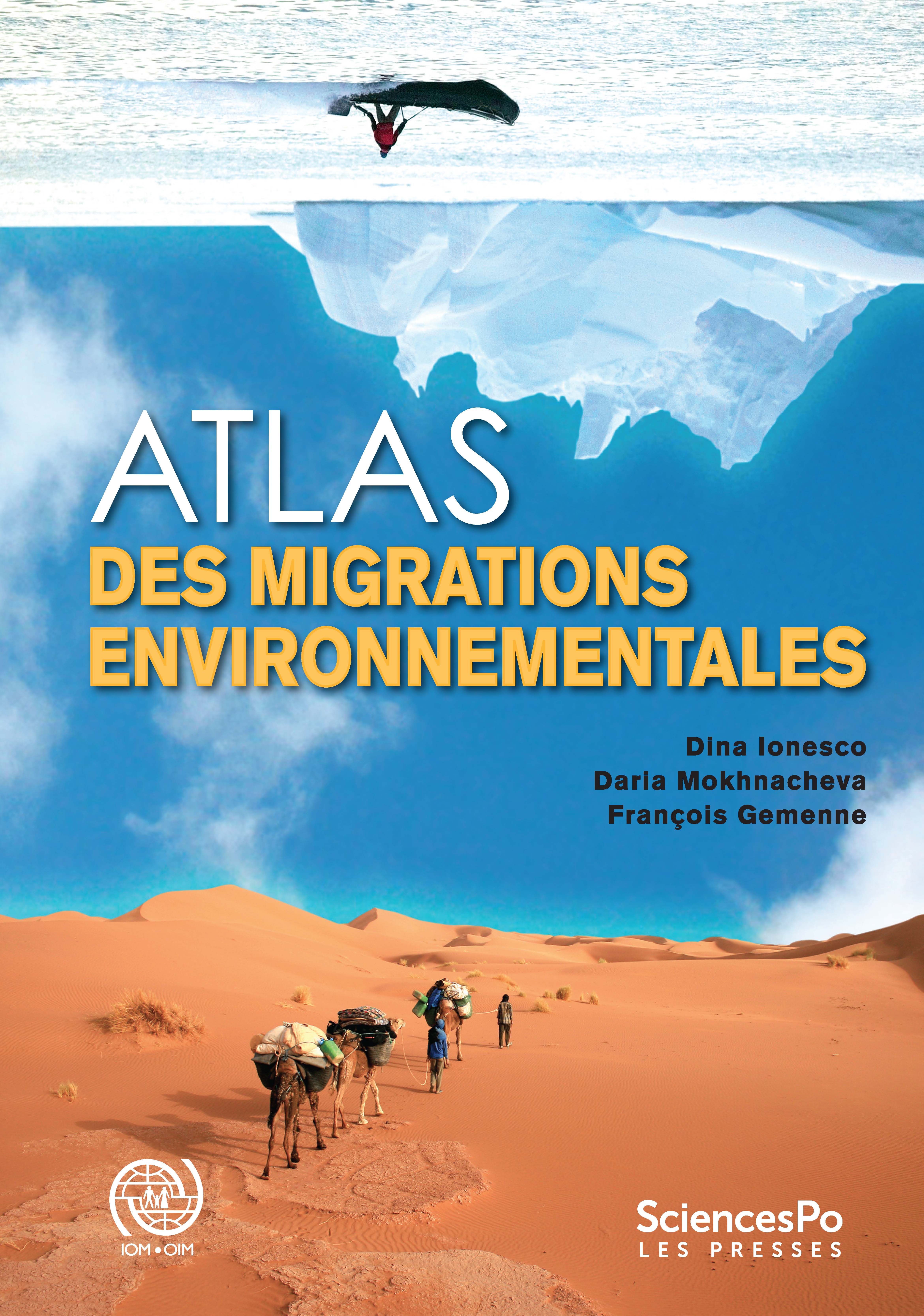
The Atlas of Environmental Migration was officially launched as part of International Organisation for Migration’s (IOM) exhibition “Entwined Destinies: Migration, Environment and Climate Change,” which is organized in Paris from 24 November to 17 January at the Palais de la Porte Dorée in partnership with the Heinrich Böll Foundation. Videos related to environmental migration filmed during the launch include interviews with Dina Ionesco (Head of Migration, Environment and Climate Change Division at IOM), with John Pappas (Associate Producer of Years of Living Dangerously, National Geographic Channel) and Emilie Chevalier (PhD student in Geography at University of Limoges in France & Sydney, Australia).

Video courtesy: Climate Vulnerable Forum (CVF)
Filmscreenings organized in the framework of the Entwined Destinies: Migration, Environment and Climate Change exhibition. Flyer Dépliant
- There Once Was an Island: Te Henua e Nnoho (2010) Briar March Saturday, December 5, 2015, 16h30-19h
The people of Takuu, a small island in the Pacific Ocean are threatened by rising sea levels. As a result of climate change, their ancestral land and culture may disappear. Migration is one of the only options left to them.
- Les Guerriers de la pluie – Tanzanie and Changement d’adresse pour cause de sécheresses – Kenya: Episode 3 and 2 of the series Expédition Grand Rift (2012), Geoffroy and Loïc de la Tullaye Sunday, December 13, 2015, 16h30-19h
In Tanzania and Kenya, droughts and environmental degradation threaten the traditional livelihoods of farmers and pastoralists. Poverty and food insecurity are pushing these people to migrate to large cities in search of a better life.
Free admission, limited seating available. Arrive 30 minutes before the start of the projection. Screenings followed by discussions with filmmakers and experts on climate change and migration.
Please visit the Entwined Destinies: Migration, Environment and Climate Change event page or IOM France page for more information.
For all IOM events at COP21, please consult our calendar here.
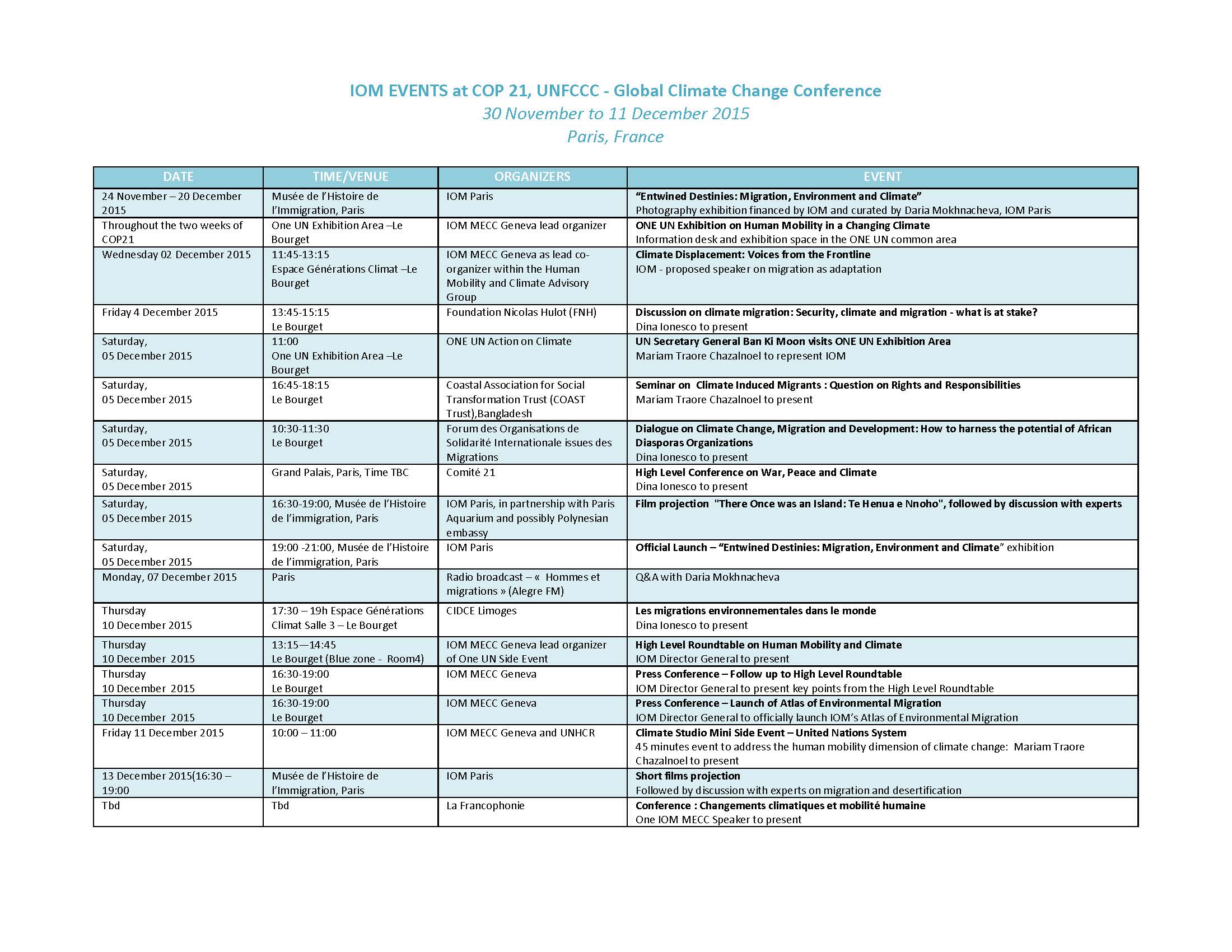
- News
-
Photo Exhibition - Entwined destinies: Migration, environment and climate change
Photographer...UNFCCC COP 21/ CMP 11 - Twenty-first session of the Conference of the Parties and the eleventh session of the Conference of the Parties serving as the meeting of the Parties to the Kyoto Protocol
The December 2015 Conference will be one of the biggest international climate conferences ever....Sécurité, climat & migrations: Quels liens? Quels enjeux?
Dans le cadre de sa programmation citoyenne au Bourget, la Fondation Nicolas Hulot vous invite à une conférence...COP21 Side Event: Climate Change Resilience in the Age of Data
COP21 Side Event: Climate Change Resilience in the Age of DataHigh Level Conference on War, Peace and Climate
Time: 14.00Les migrations environnementales dans le monde
Time: 17h00-18h30 - Events
-